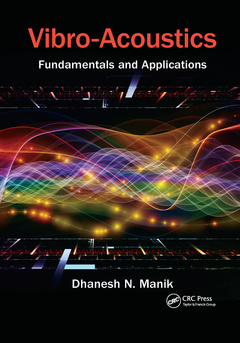Vibro-Acoustics Fundamentals and Applications
Auteur : Manik Dhanesh N.

The subject of vibro-acoustics is important for the design of machine elements and structures, to minimize sound generated by them. For better machine designing, it is necessary for machine designers (mechanical engineers) to have a thorough knowledge of vibro-acoustics. Furthermore, since the design cycles of machines have become shorter, designers will have to design quiet machines at the drawing-board stage rather than applying "band-aid" techniques after the machine has been built.
Although there is common ground in the treatment of acoustics, the subject of vibration is not very fortunate. Those interested in low-frequency vibration are generally concerned with the modal approach of using natural frequencies and mode shapes, whereas those interested in vibro-acoustics in medium and high frequencies are generally concerned with the wave approach. Since both modal and wave approaches have their advantages, it is a good idea to study both together to get the best out of them. This is useful for a better understanding the physics of vibro-acoustics. Written for students and professionals interested in gaining knowledge, this book systematically integrates the relevant aspects of vibro-acoustics from various viewpoints.
Contents
Preface............................................................................................................................................ xiii
Acknowledgments.........................................................................................................................xv
Author........................................................................................................................................... xvii
- Single-Degree-of-Freedom (SDOF) System
- Multidegree of Freedom (MDOF) Systems and Longitudinal Vibration in Bars
- Airborne Sound
- Random Vibration
- Flexural Vibration of Beams
- Flexural Vibration of Plates and Shells
- Sound Sources
- Room Acoustics
- Sound–Structure Interaction
- Statistical Energy Analysis (SEA)
Bibliography
Index
Dhanesh N. Manik was born in Mysore, India. He graduated with a bachelor’s degree in mechanical engineering from Mysore University in 1982, master’s degree in mechanical engineering from Indian Institute of Science (I.I.Sc.), Bangalore, in 1985, and PhD in mechanical engineering from Auburn University, U.S.A, in 1991. He has also briefly worked at Hindustan Aeronautics (Helicopter Division), Bangalore, from 1985 to 1986. He joined the faculty of Indian Institute of Technology Bombay (IITB) in 1992 and is currently a professor in mechanical engineering. His main areas of research are statistical energy analysis (SEA) and machinery diagnostics. He is a member of the International Institute of Acoustics and Vibration, Acoustical Society of India and National Committee on Noise Pollution Control, Central Pollution Control Board, India. He is a consultant to many projects from industry related to vibration and noise and regularly conducts continuing education programs to industry professionals on vibration and noise. He has authored the book on control systems (Cengage India 2012).
Date de parution : 12-2020
17.8x25.4 cm
Date de parution : 04-2017
17.8x25.4 cm
Thèmes de Vibro-Acoustics :
Mots-clés :
Sound Pressure Level; Octave Band; vibro-acoustics textbook; Bending Wave Number; advanced structural dynamics and acoustics; Bending Wave Speed; sound-structure interaction; Coupling Loss Factor; Sound Power; Sound Power Level; Airborne Sound; Flexural Vibration; Modal Density; Radiation Impedance; Mode Shapes; Particle Velocity; Dynamic Pressure; Bending Wave; Acoustic Absorption Coefficient; Sound Structure Interaction; SDOF System; Undamped Natural Frequency; Half Power Frequencies; Acoustic Absorption Materials; Time Dependent Random Variable; Radiation Ratio; Room Constant; Monopole Source



